全文HTML
--> --> -->根据抽运方式的不同, 将SC的产生方式分为以下两种. 一种是利用单束光抽运MSF产生SC. 当抽运光位于MSF的不同色散区时SC的产生机理有所不同, 抽运光位于正常色散区时SC的产生机理以自相位调制作用为主[9-11], 位于反常色散区时产生机理以高阶孤子分裂、拉曼孤子自频移、色散波为主[12-14]. 另一种是抽运光和种子光同时耦合进活性光纤, 利用活性离子的波长转换和放大作用产生SC. 活性光纤通常为掺镱微结构光纤(Yb3+-doped microstructure fiber, Yb3+-MSF), 种子光在非线性作用下产生SC, 而Yb3+吸收抽运光并放大种子光, 使得种子光在光纤中传输时维持较高峰值功率. 2007年, Roy等[15]利用975 nm的连续光和1062 nm的纳秒脉冲同时耦合进具有双包层的Yb3+-MSF中, 种子光在非线性效应的作用下于正常色散区产生波长范围为500—900 nm的SC. 2016年, Louot等[16]利用980 nm的连续光和1064 nm的皮秒脉冲同时耦合进Yb3+-DPCF, 产生波长范围为1064—1600 nm的SC并应用于CARS光谱. 2016年, Baselt等[17]利用976 nm的连续光和1064 nm的纳秒脉冲同时耦合进Yb3+-MSF, 得到平坦、高功率密度的波长范围为1100—1370 nm的SC. 2017年, Baselt等[18]又建立了微分效率较高的全光纤SC系统并得到波长范围为1.1—1.4 μm的SC. 为保证Yb3+-MSF的吸收效率, 选择输出波长为975, 976或980 nm的激光器作为抽运光源, 这些激光器的输出光通常为连续光, 但连续光的峰值功率较低. 而为了在较短MSF内产生SC, 需在MSF中同时注入种子光以增加非线性转换效率, 但这同时也增加了实验系统的复杂性. 文献[19]证明了可以采用钛蓝宝石飞秒激光器抽运Yb3+-MSF产生SC, 抽运波长位于MSF的正常色散区, Yb3+的发射峰位于MSF的反常色散区, 利用飞秒脉冲的高峰值功率, 结合Yb3+的波长转换和放大的作用产生SC.
本文首先对自制Yb3+-MSF1和Yb3+-MSF2的色散特性进行数值模拟并得到了两MSFs的零色散点波长; 然后利用连续光分别抽运两MSFs, 研究了抽运光偏离Yb3+吸收峰的程度对两MSFs发光效率的影响; 接着利用钛蓝宝石飞秒激光器分别抽运两MSFs, 研究了抽运功率、发射光与零色散点的相对位置对超连续谱的影响, 以及抽运波长、MSF长度对超连续谱的影响; 最后对Yb3+-MSF2进行拉锥, 对锥区处色散特性变化对色散波蓝移的影响以及光能量泄露对拉曼孤子红移的影响进行了研究. 与同时将抽运光与种子光耦合进Yb3+掺杂MSF的实验方案相比, 采用钛蓝宝石飞秒激光器作为唯一的抽运源, 减小了实验系统的复杂性, 同时还可以利用钛蓝宝石飞秒激光器的波长可调特性, 得到在一定波长范围之内的可调谐SC.
2.1.色散模拟
图1为自制Yb3+-MSF1和Yb3+-MSF2的基模色散曲线图, 插图(a)和图(b)分别为两MSFs端面图. Yb3+-MSF1和Yb3+-MSF2纤芯采用同种掺Yb3+玻璃, 纤芯材料的质量百分比为1.5Yb2O3-3.0Al2O3-0.5K2O-95.0SiO2, 用阿贝折射仪测得在波长589 nm处纤芯折射率为1.519. 由数字显微镜测得Yb3+-MSF1的空气孔平均直径为4.29 μm, 平均孔间距为5.16 μm, 纤芯掺杂区域直径为3.75 μm, 空气孔层数为8层, MSF外径为153.34 μm. Yb3+-MSF2的空气孔平均直径为3.78 μm, 平均孔间距为4.03 μm, 纤芯掺杂区域直径为3.14 μm, 空气孔层数为8层, MSF外直径为109.69 μm. 利用多极法模拟得到Yb3+-MSF1和Yb3+-MSF2的零色散波长分别位于1027和950 nm处.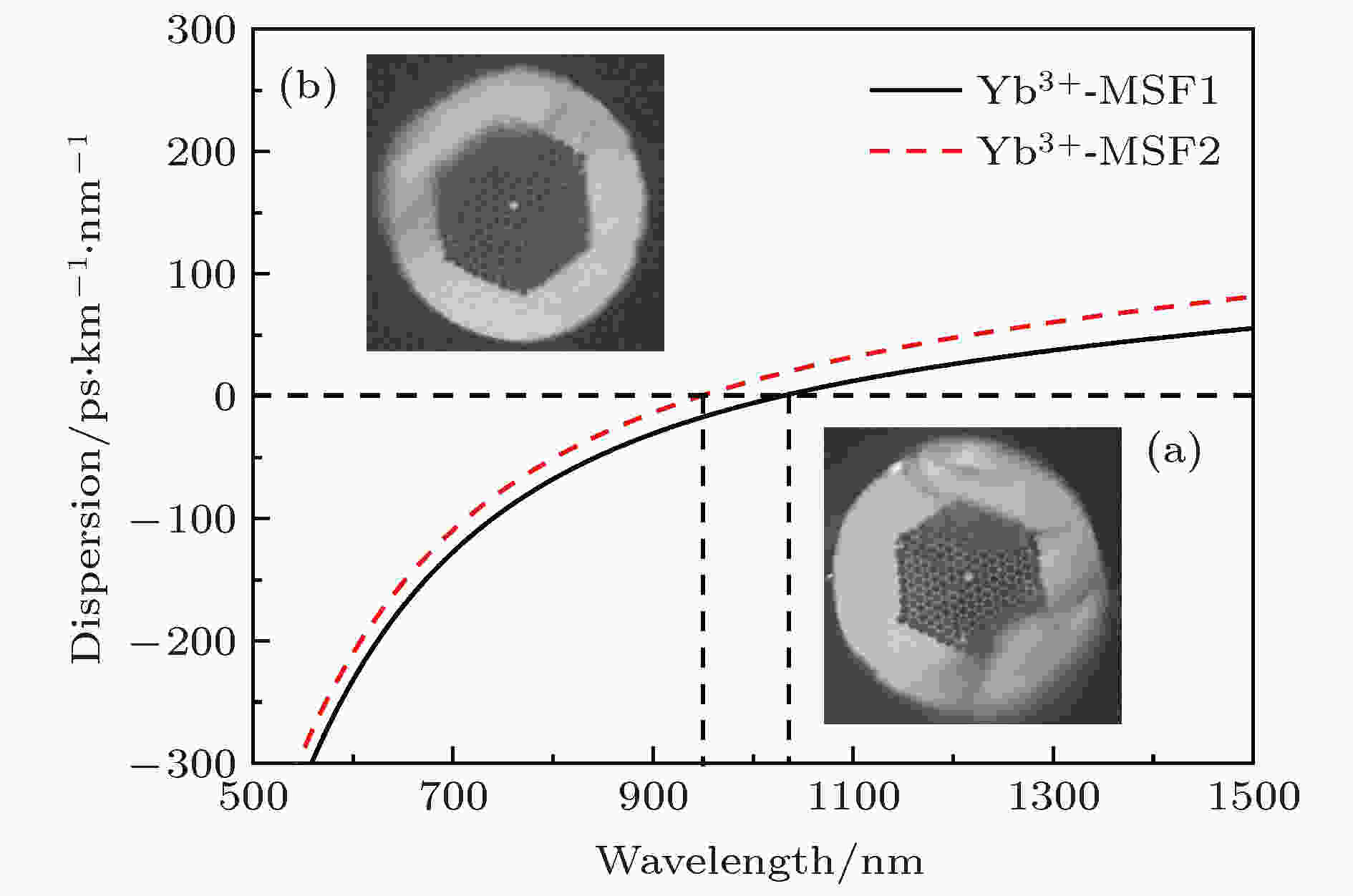 图 1 Yb3+-MSF1、Yb3+-MSF2基模色散曲线图 (插图(a)和(b)分别为Yb3+-MSF1, Yb3+-MSF2端面图)
图 1 Yb3+-MSF1、Yb3+-MSF2基模色散曲线图 (插图(a)和(b)分别为Yb3+-MSF1, Yb3+-MSF2端面图)Figure1. Dispersion curve of the fundamental mode of Yb3+-MSF1 and Yb3+-MSF2, respectively (the inset figures show the cross section of the Yb3+-MSF1 (a) and the Yb3+-MSF2 (b)).
2
2.2.发射光谱特性
图2为Yb3+-MSF2在不同波长的连续光抽运下测得的发射光谱图, 其中实验用MSF长度为0.70 m, 功率为0.40 W, 波长分别为850, 870, 890 nm. 图2插图中实线和虚线分别表示的是Yb3+在石英光纤中的吸收和发射截面[20]. 由图2插图可知, Yb3+存在两个强烈的吸收峰, 中心波长分别为915和975 nm, 同时也可以看出, Yb3+的吸收光谱很宽, 波长覆盖850—1050 nm, Yb3+的发射光谱覆盖900—1150 nm, 在该区间内也有两个比较明显的发射峰, 中心波长分别位于975和1035 nm处.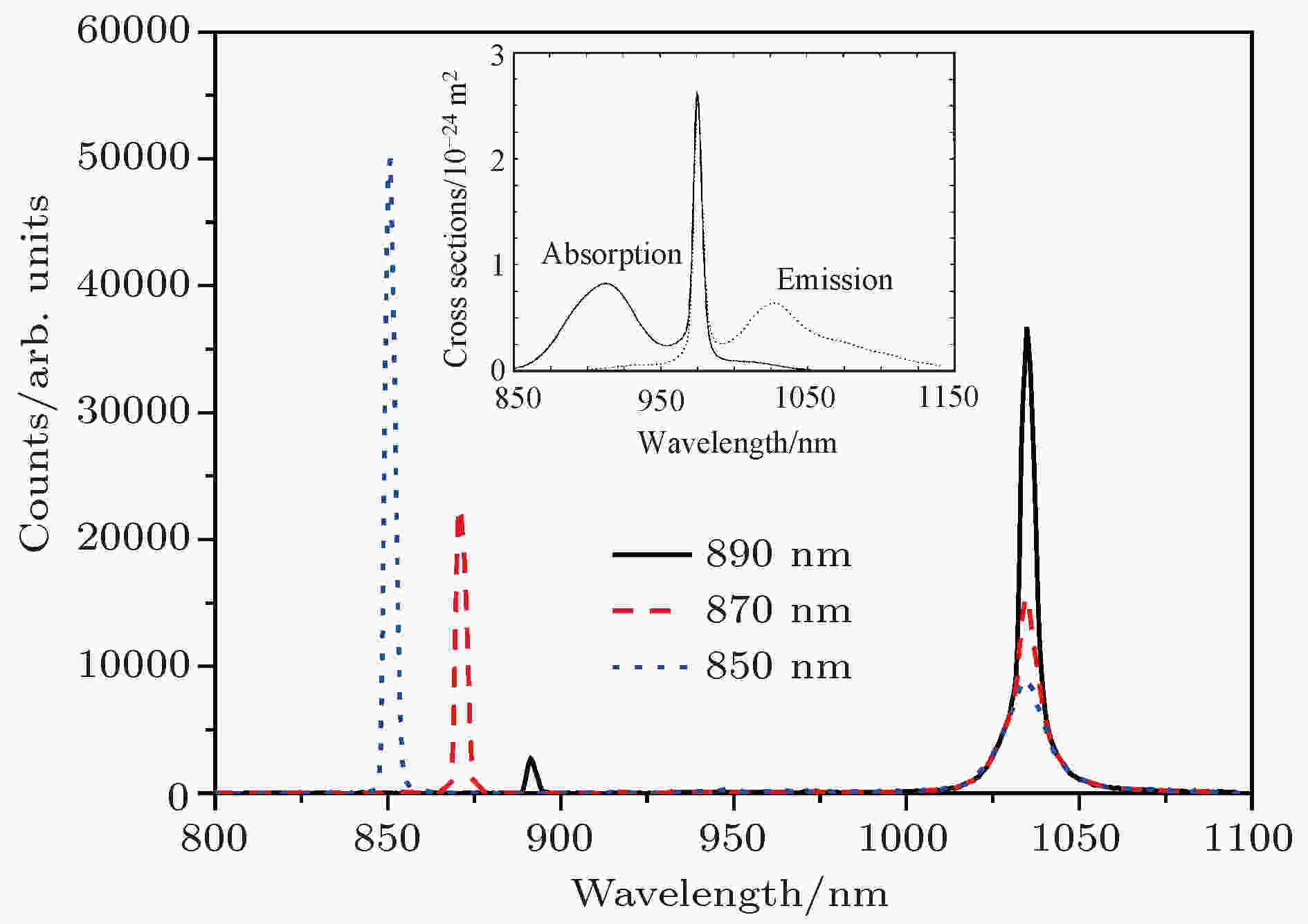 图 2 抽运波长为850, 870, 890 nm时Yb3+-MSF2的发射光谱图(插图为Yb3+在石英光纤中的吸收和发射光谱图[20])
图 2 抽运波长为850, 870, 890 nm时Yb3+-MSF2的发射光谱图(插图为Yb3+在石英光纤中的吸收和发射光谱图[20])Figure2. Emission spectrum of the Yb3+-MSF2 when pump wavelength is 850, 870 and 890 nm, respectively (the inset figure shows the absorption and emission spectrum of Yb3+ in silica fiber[20]).
对于Yb3+-MSF2, 当抽运波长由850 nm逐渐增大至890 nm时, 发射峰的中心波长均位于1035 nm处, 同时抽运光的峰值在逐渐下降, 发射峰峰值逐渐增高. 采用输出光谱中发射光占总光谱面积百分比γ来进行Yb3+的发光效率的定量描述. 当抽运波长由850 nm 增长至890 nm时, 其γ值由46.7%增至96.9%, 所以当抽运波长为890 nm时, 虽然偏离吸收最高峰达85 nm, 但仍然有较高的发光效率. 由图2还可得知, 当抽运波长从850 nm变化至890 nm时, 其在MSF出射端的光谱并未发生展宽. 这是因为利用连续光抽运Yb3+-MSF时, 发射光也为连续光, 尽管其功率沿MSF纵向逐渐积累, 但由于连续光峰值功率低, 因此没有明显的非线性效应产生. Yb3+-MSF1在纤芯区域的掺杂材料与Yb3+-MSF2相同, 因此在发射光谱特性上与图2展示的结果相同, 发射峰中心波长同样位于1035 nm处, 同时当抽运波长由850 nm增至890 nm时, 其γ值由45.2%增至84.8%, 同样具有较高发光效率.
 图 3 实验装置图
图 3 实验装置图Figure3. The experimental setup.
4.1.抽运功率、发射光与零色散波长相对位置对超连续谱产生的影响
图4和图5分别为Yb3+-MSF1和Yb3+-MSF2在不同抽运功率下产生的光谱图, 其中MSF长度为0.70 m, 抽运波长为890 nm, 抽运功率分别为0.10, 0.20、0.30, 0.40 W. 图4与图5中的点划线(绿色)、虚线(蓝色)和实线(红色)的位置分别代表了抽运光波长、零色散波长和发射光波长. 从图4中可以看出, 抽运光均位于两根MSFs的正常色散区, 而发射光分别位于Yb3+-MSF1的零色散波长附近以及Yb3+-MSF2的反常色散区. 插图分别为CCD接收到的两MSFs光场位置图, 从图4可以看出抽运光已经耦合进纤芯.由图4得知, 当抽运功率为0.10 W时, 抽运光相对于入射光谱来说有了一定程度的展宽, 这种展宽由自相位调制作用产生的. 与图2中连续光抽运情况相比, 位于1035 nm的发射光的半高宽并没有明显变化, 这是由于发射光沿MSF积累的功率较弱, 并没有非线性效应产生. 本实验中, 稀土离子的吸收再发射和超连续谱展宽效应共同参与飞秒抽运光的能量转移, 为了衡量超连续谱产生效率, 同时去除抽运光耦合效率、MSF损耗等因素的影响, 定义输出光谱中超连续谱的产生效率η=1–Srp/S, 其中Srp为接收到光谱中的残余抽运光面积, 包含飞秒抽运光和发射光两部分, S为接收到光谱的总面积. 当抽运功率增加到0.20 W时, 抽运光的自相位调制作用进一步增强, 但由于波长大于870 nm的部分被Yb3+完全吸收, 故只观察到输出端光谱蓝移; 对于发射光, 其强度随抽运功率增加而增强, 但仍没有明显的非线性效应产生. 当抽运功率增加到0.30 W时, 在反常色散区出现基阶孤子. 孤子是反常色散及非线性平衡作用下的结果, 然而抽运光位于正常色散区, 所以孤子并非由抽运光产生, 而是由位于零色散波长附近的发射光产生, η=87.4%. 与图2对比可以发现, 虽然抽运功率为0.40 W的连续光平均功率高于0.30 W的飞秒脉冲, 但是利用连续光抽运MSF时, 并未在反常色散区产生孤子. 因此此处产生孤子的原因可以解释为: 位于1035 nm的发射光在被飞秒脉冲抽运激发、放大的同时被俘获并演化成超短脉冲, 尽管飞秒脉冲平均功率较低, 但是其峰值功率很高, 可于反常色散区在非线性作用下产生基阶孤子. 基阶孤子在拉曼作用下红移至1112 nm, 与此同时, 在满足相位匹配条件的相应波长下产生色散波并蓝移至692 nm. 当抽运功率增加至0.40 W时, 拉曼孤子进一步红移至1256 nm, 并伴随着色散波蓝移至621 nm, η达到93.5%.
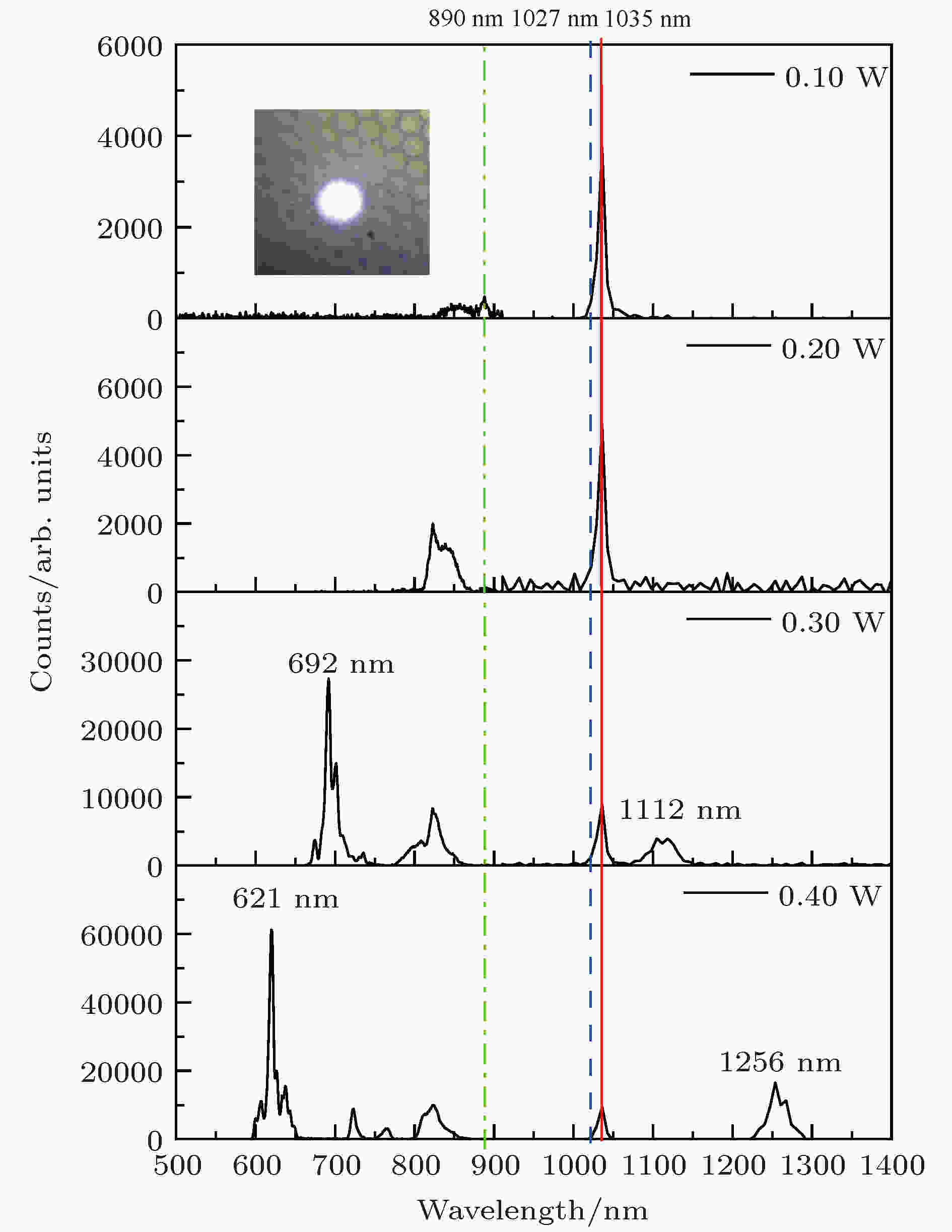 图 4 抽运功率分别为0.10, 0.20, 0.30, 0.40 W时Yb3+-MSF1产生的光谱图(插图为光场位置图)
图 4 抽运功率分别为0.10, 0.20, 0.30, 0.40 W时Yb3+-MSF1产生的光谱图(插图为光场位置图)Figure4. The optical spectrum of Yb3+-MSF1 when pump power is 0.10, 0.20, 0.30 and 0.40 W, respectively (the inset figure shows optical field position).
由图5可知, 当抽运功率为0.10 W时, Yb3+-MSF2产生现象与Yb3+-MSF1类似, 只有抽运光在一定程度上发生了展宽, 在反常色散区的发射光谱并未出现明显展宽. 当抽运功率增加至0.20 W时, 发射光在反常色散及非线性效应的共同作用下产生中心波长为1111 nm的基阶孤子及761 nm的色散波, η=83.3%. 当抽运功率增加至0.30 W时, 在反常色散区产生高阶孤子并分裂成多个基阶孤子, 各基阶孤子在拉曼作用下发生红移, 同时在满足相位匹配条件的波长处产生色散波并发生蓝移, 在正常色散区由于自相位调制、色散波的作用得到645—878 nm的SC. 当抽运功率增加至0.40 W时, 拉曼孤子进一步红移, 在反常色散区由于高阶孤子分裂、拉曼孤子自频移的作用使得光谱展宽合并得到1016—1346 nm的SC, 在正常色散区SC的蓝移边缘进一步蓝移至623 nm处. 上述两种情况, η均大于98%. 由于自制的Yb3+-MSF并未进行脱水处理, 使得位于1380 nm处的OH-吸收限制了拉曼孤子的红移以及色散波的蓝移, 进而影响了SC的展宽. 另外, 由于Yb3+的强吸收作用使得频谱分为两部分. 对比图4及图5可以发现, Yb3+-MSF1的发射光位于零色散波长附近, 利用飞秒脉冲抽运Yb3+-MSF1时产生孤子效应; 而相较于Yb3+-MSF1和Yb3+-MSF2的纤芯较小, 非线性系数较大, 且发射光位于距离零色散波长较远的反常色散区, 利用飞秒脉冲抽运Yb3+-MSF2时更容易产生高阶孤子分裂效应得到SC, 因此具有更高的超连续谱产生效率.
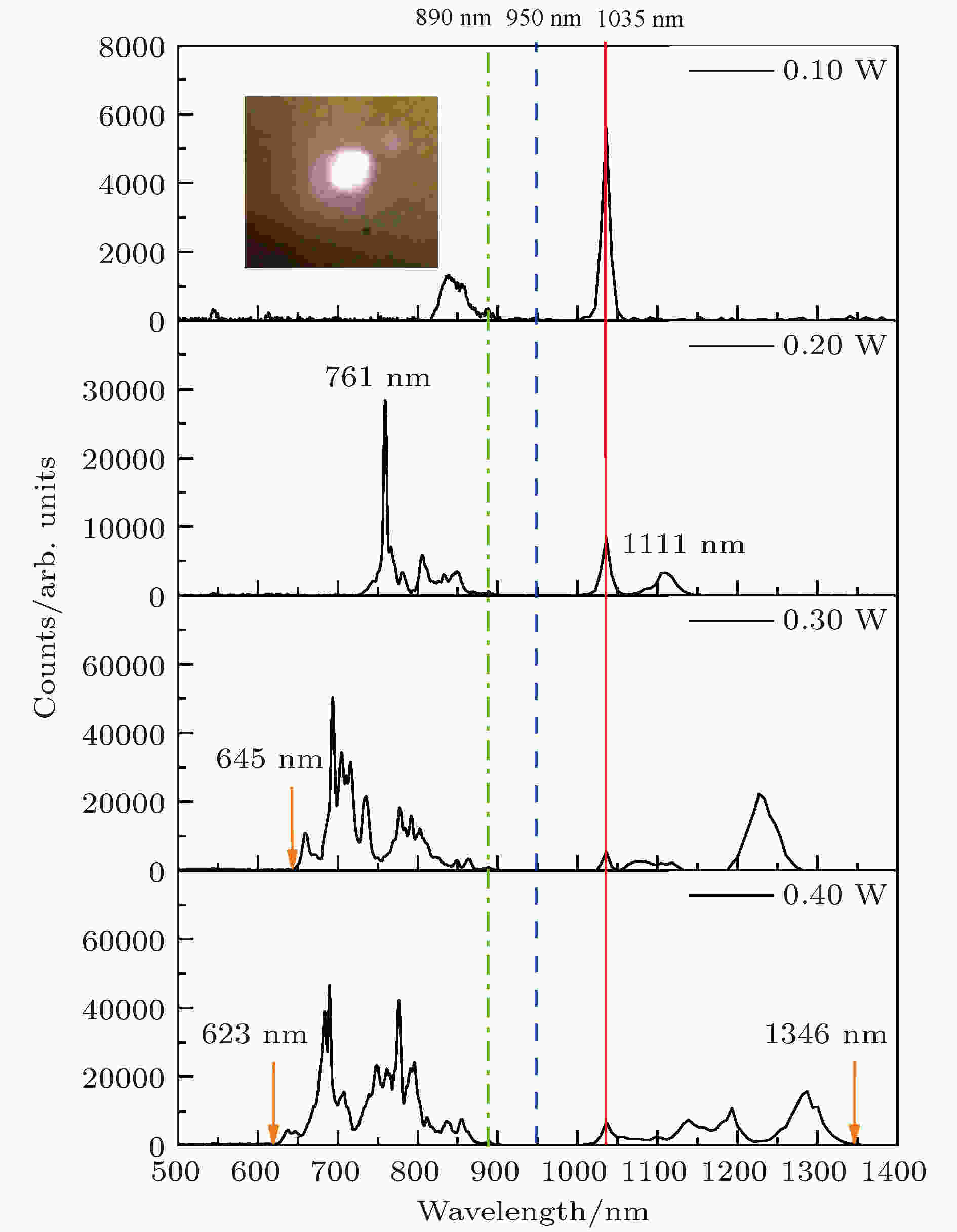 图 5 抽运功率分别为0.10, 0.20, 0.30, 0.40 W时Yb3+-MSF2产生的光谱图(插图为光场位置图)
图 5 抽运功率分别为0.10, 0.20, 0.30, 0.40 W时Yb3+-MSF2产生的光谱图(插图为光场位置图)Figure5. The optical spectrum of Yb3+-MSF2 when pump power is 0.10, 0.20, 0.30 and 0.40 W, respectively (The inset figure shows optical field position).
2
4.2.抽运波长对超连续谱产生的影响
图6和图7分别为Yb3+-MSF1和Yb3+-MSF2在不同抽运波长下产生的光谱图, 其中, MSF长度为0.70 m, 抽运功率为0.40 W, 抽运波长分别为850, 870, 890 nm. 由图6可知, 当抽运波长从890 nm蓝移至870 nm时, 拉曼孤子中心波长从1256 nm移至1161 nm, 色散波中心波长从621 nm移至662 nm, 这是由于抽运波长偏离Yb3+吸收峰的程度增加, 使得Yb3+吸收能力降低, 发射光沿程积累的功率较低, 导致拉曼孤子的能量较弱, 进而限制了孤子的红移以及色散波的蓝移; 而当抽运波长为850 nm时, Yb3+吸收效率更低, 使得发射光的功率更弱, 未产生孤子及色散波. 当抽运波长为850和870 nm时, η分别为65.2%和91.9%.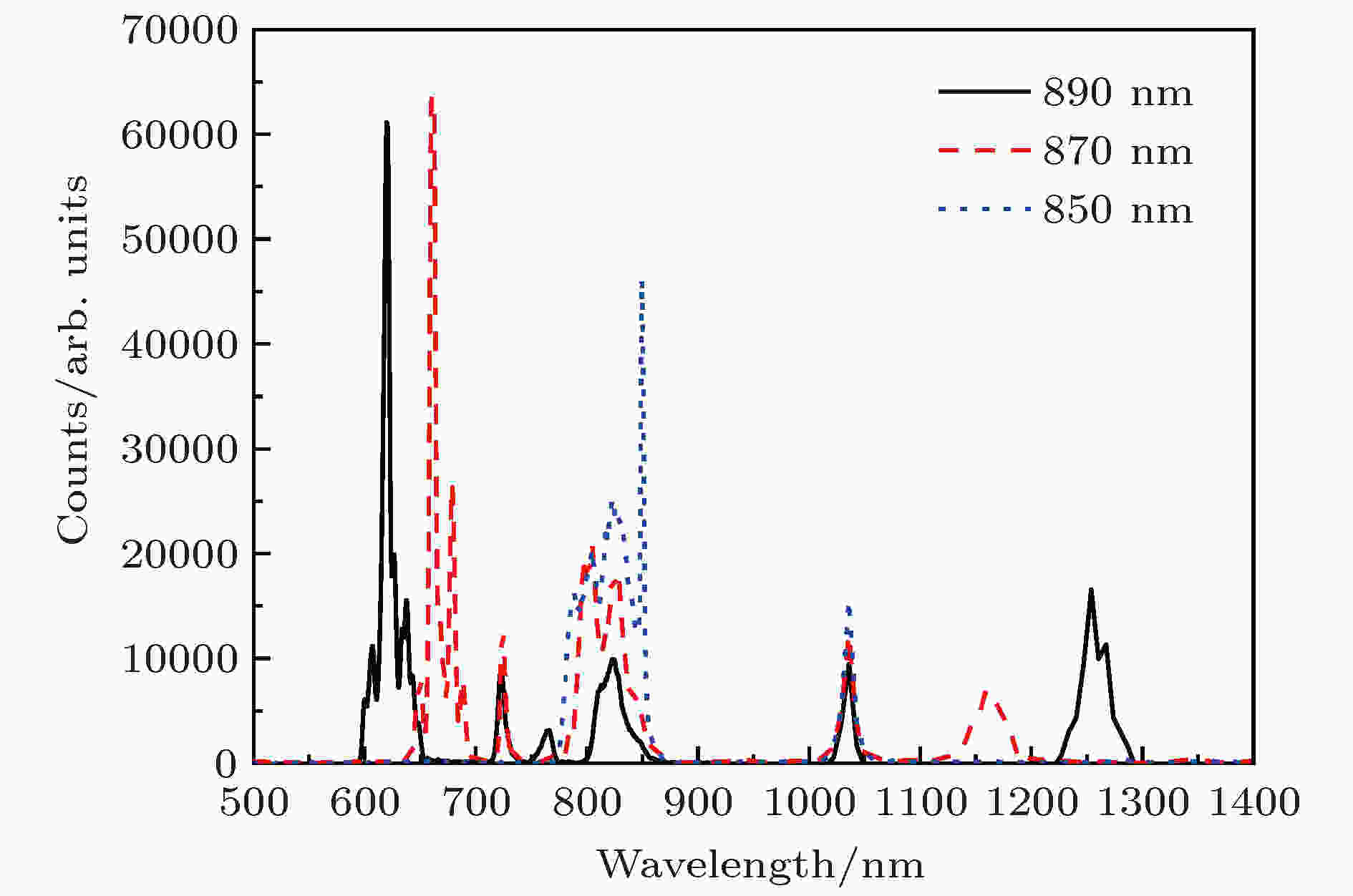 图 6 抽运波长分别为850, 870, 890 nm时Yb3+-MSF1产生的光谱图
图 6 抽运波长分别为850, 870, 890 nm时Yb3+-MSF1产生的光谱图Figure6. The optical spectrum of Yb3+-MSF1 when the pump wavelength is 850, 870 and 890 nm, respectively.
由图7可知, 当抽运波长从890 nm变化至870 nm时, Yb3+-MSF2的SC红移边缘从1346 nm移至1249 nm, 蓝移边缘从623 nm移至670 nm; 当抽运光为850 nm时, 在反常色散区没有非线性效应, 在正常色散区仅由于抽运光自相位调制的作用使得光谱展宽至771 nm. 结合图6及图7可知, 抽运光的吸收效率对于SC的产生极其重要, 当抽运光波长靠近Yb3+吸收峰时, 两MSFs吸收效率高, 发射光积累的功率强, Yb3+-MSF1产生的拉曼孤子红移距离远, Yb3+-MSF2产生的SC范围宽. 同时还可得知, 抽运波长可不必位于Yb3+吸收峰处, 当抽运波长位于偏离吸收最高峰85 nm的890 nm时, MSF仍有较高的吸收和发射效率, 并产生较宽范围的SC, 在抽运波长为850和870 nm时的η分别为65.3%和95.2%, 略高于Yb3+-MSF1. 虽然受本实验室激光器的限制, 飞秒脉冲波长仅能调至890 nm, 但目前商用钛蓝宝石飞秒激光器的输出波长可覆盖660—1200 nm, 以钛蓝宝石飞秒激光器作单抽运源, 结合超短脉冲高峰值功率和波长可调谐特性对输出光谱进行灵活调节得到可调谐SC, 利用飞秒脉冲抽运Yb3+-MSF是一种非常有前景的SC产生方式.
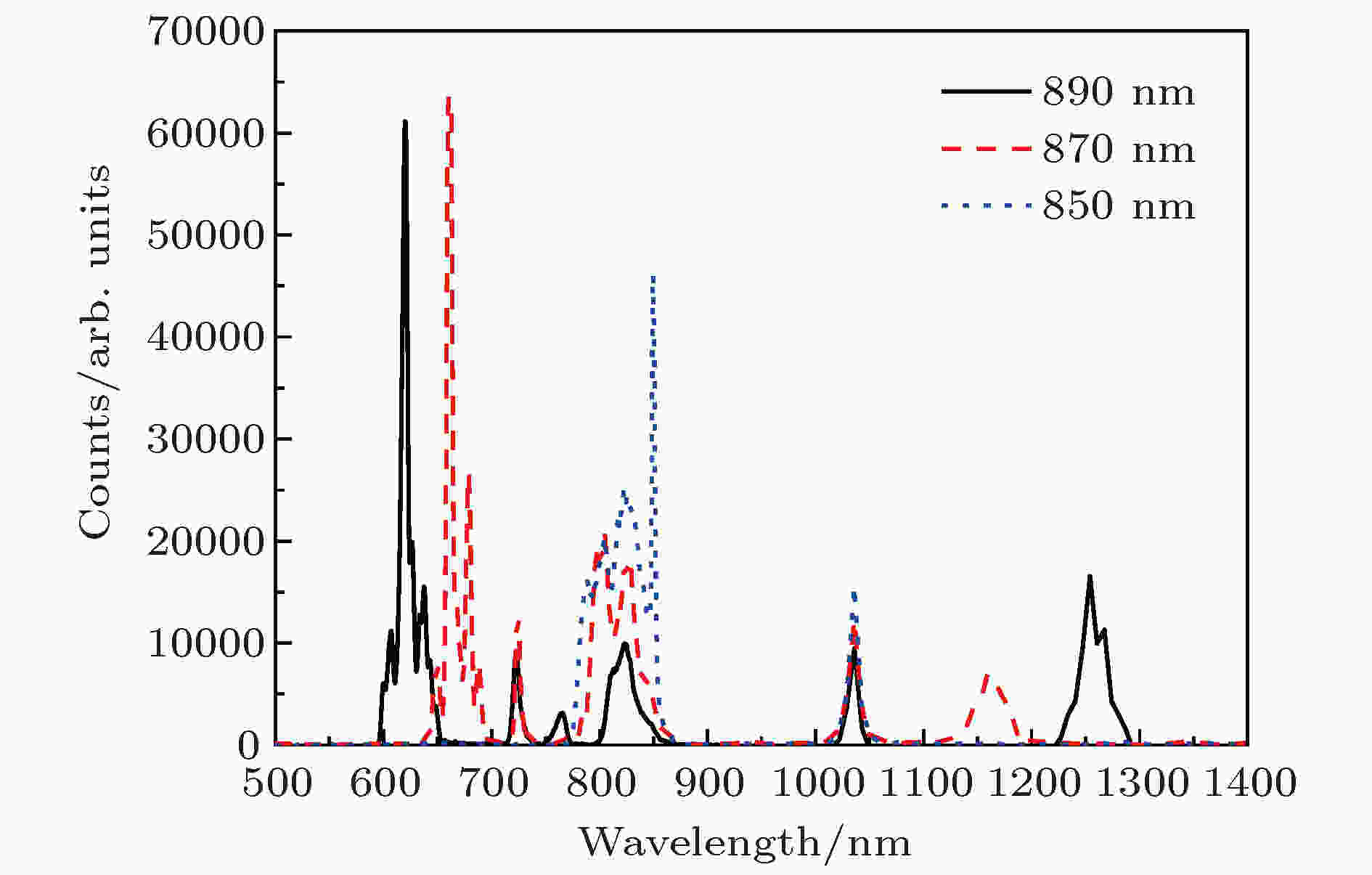 图 7 抽运波长分别为850, 870, 890 nm时Yb3+-MSF2产生的光谱图
图 7 抽运波长分别为850, 870, 890 nm时Yb3+-MSF2产生的光谱图Figure7. The optical spectrum of Yb3+-MSF2 when the pump wavelength is 850 and 890 nm, respectively.
2
4.3.MSF长度对超连续谱产生的影响
图8和图9分别为Yb3+-MSF1和Yb3+-MSF2在不同MSF长度下产生的光谱图, 其中, 抽运波长为890 nm, 抽运功率为0.40 W, MSF长度分别为0.50和0.70 m. 从图7中可知, 当MSF长度从0.70 m缩短至0.50 m时, Yb3+-MSF1产生的拉曼孤子中心波长从1256 nm移至1102 nm, 色散波中心波长从621 nm移至692 nm; Yb3+-MSF2产生的SC红移边缘从1346 nm移至1254 nm, 蓝移边缘从623 nm移至661 nm. 分析其原因为: MSF长度缩短使得Yb3+作用距离缩短, 发射光沿程积累的功率较弱, 导致Yb3+-MSF1拉曼孤子红移距离及色散波蓝移距离减小, Yb3+-MSF2产生的SC范围减小.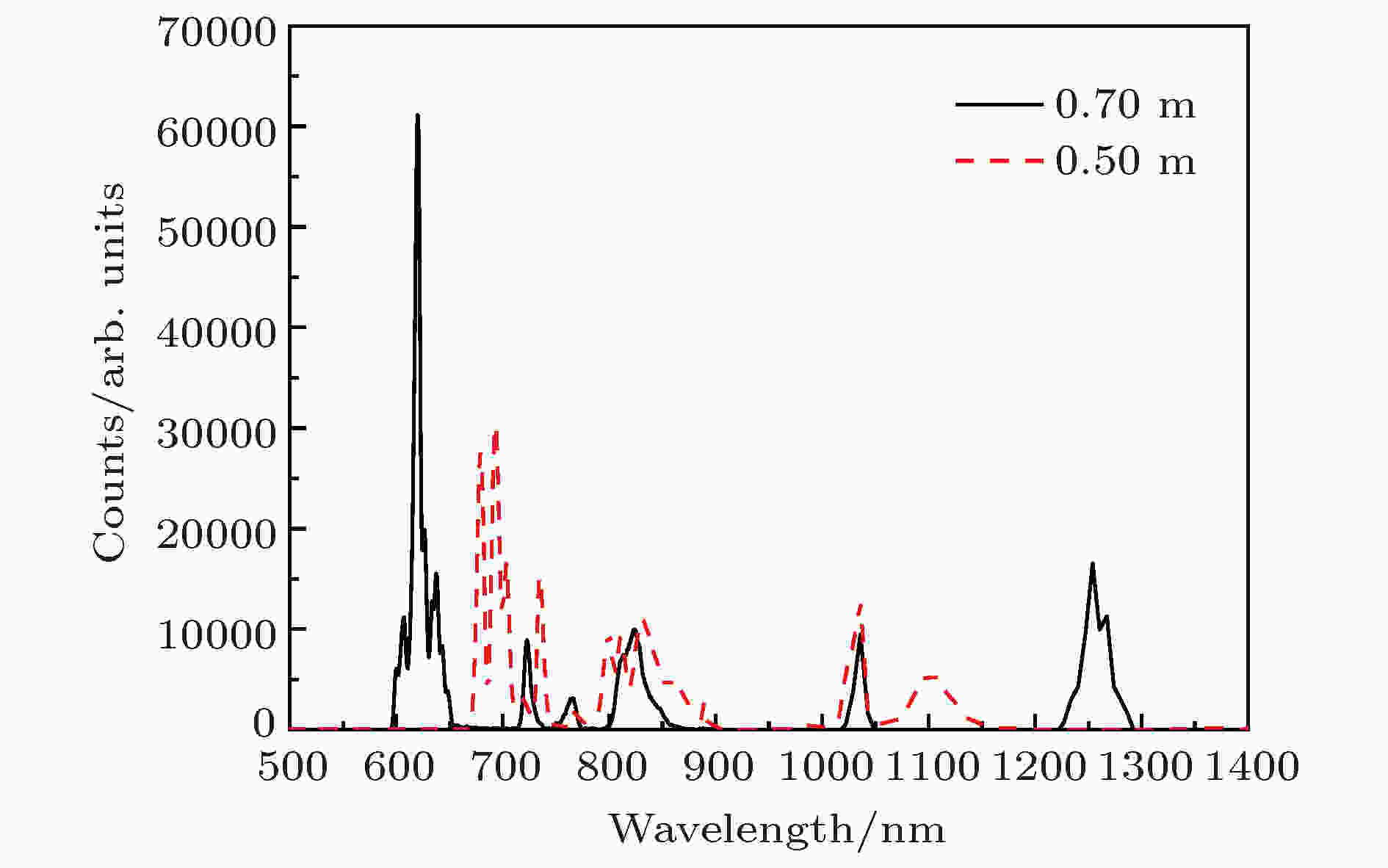 图 8 MSF长度为0.50, 0.70 m时Yb3+-MSF1的光谱图
图 8 MSF长度为0.50, 0.70 m时Yb3+-MSF1的光谱图Figure8. The optical spectrum of Yb3+-MSF1 when fiber length is 0.50 and 0.70 m, respectively.
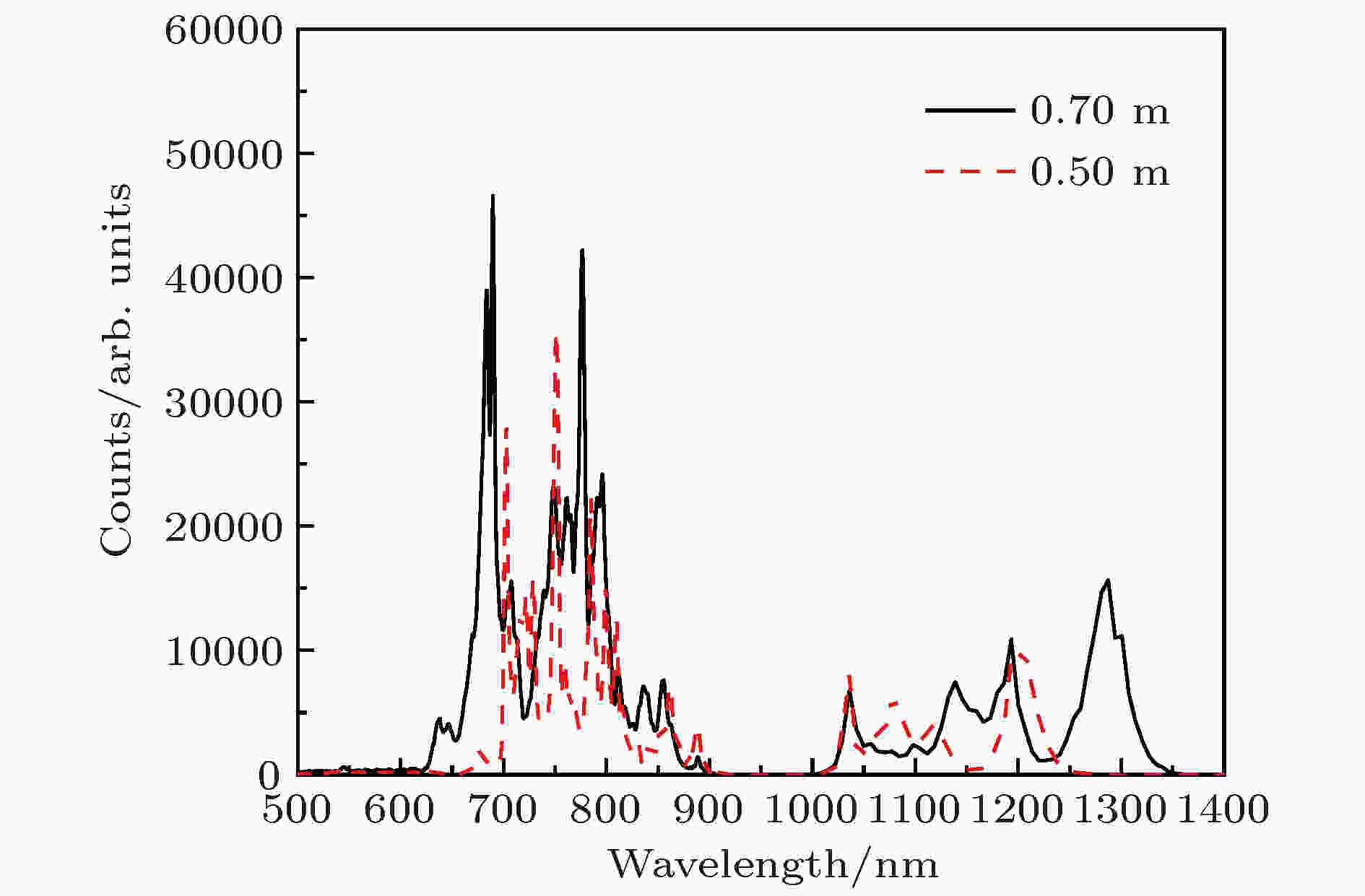 图 9 MSF长度为0.50, 0.70 m时Yb3+-MSF2的光谱图
图 9 MSF长度为0.50, 0.70 m时Yb3+-MSF2的光谱图Figure9. The optical spectrum of Yb3+-MSF2 when fiber length is 0.50 and 0.70 m, respectively.
5.1.色散模拟
拉锥可改变MSF的色散特性[21], 但同时也会产生光泄露, 为研究这些特性变化对SC产生的影响, 本文对Yb3+-MSF2进行拉锥, 研究在不同锥长下锥区处的色散变化及光泄露对SC产生的影响. 当拉锥长度分别为3, 5, 7 mm时, 测得Yb3+-MSF锥腰处的直径分别为81.08, 51.83, 35.62 μm, 相当于未拉锥Yb3+-MSF直径的0.74, 0.48, 0.32倍, 锥腰处的孔间距、空气孔直径及纤芯掺杂区域直径均等比缩小. 图10为模拟得到的未拉锥Yb3+-MSF2及不同锥长Yb3+-MSF锥腰处的色散曲线图, 随着拉锥长度增加, 零色散波长从950 nm蓝移至855, 725, 659 nm处, 当锥长为7 mm时在1890 nm出现第二个零色散点.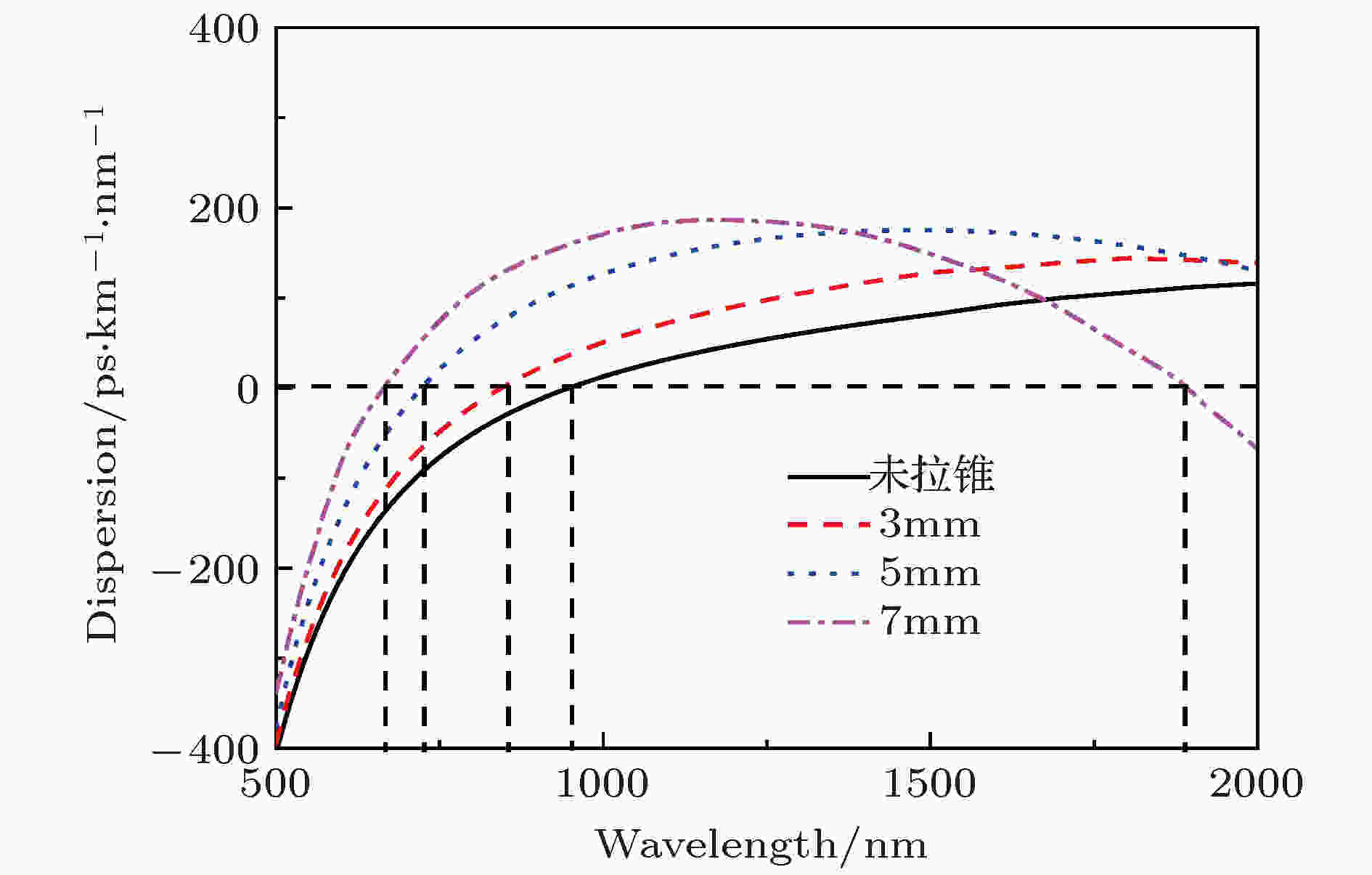 图 10 未拉锥及锥形Yb3+-MSF2锥腰处的色散曲线图
图 10 未拉锥及锥形Yb3+-MSF2锥腰处的色散曲线图Figure10. Dispersion curve of untapered Yb3+-MSF2 and tapered Yb3+-MSF2 at the taper waist.
2
5.2.飞秒脉冲抽运锥形Yb3+-MSF2时的实验结果及分析
图11为Yb3+-MSF2拉锥前后产生SC的光谱图, 其中抽运波长为890 nm, 抽运功率为0.40 W, 拉锥前Yb3+-MSF2长度为0.50 m, 锥长分别为3, 5, 7 mm, 锥腰距离Yb3+-MSF前端约0.20 m. 图11中的点划线(绿色)和实线(红色)表示抽运光和发射光的波长位置, 而虚线(蓝色)为未拉锥Yb3+-MSF及锥形MSF锥腰处的零色散波长位置. 当Yb3+-MSF拉锥后, MSF的长度和非线性系数会有一定的增加, 但是同样会在锥区引入较大的损耗, 使得抽运光的能量产生泄露, 同时因为锥区较短, 抽运光不能得到充分吸收, 从而影响到抽运光的转化效率. 另外, 锥区的零色散波长向短波方向移动, 使得抽运光位于锥区的反常色散区, 与拉曼孤子满足相位匹配条件的色散波波长发生蓝移, 从而使得短波处SC展宽, 而拉锥长度越长, 锥腰处零色散波长越小, 短波处SC展宽越宽. 从图11也可以看出, 随拉锥长度的增加, SC的红移边缘从1254 nm分别移至1243, 1177, 1159 nm, 长波处的SC范围有所缩短; 但SC的蓝移边缘分别从661 nm移至624, 563, 525 nm, 短波处的SC范围增加.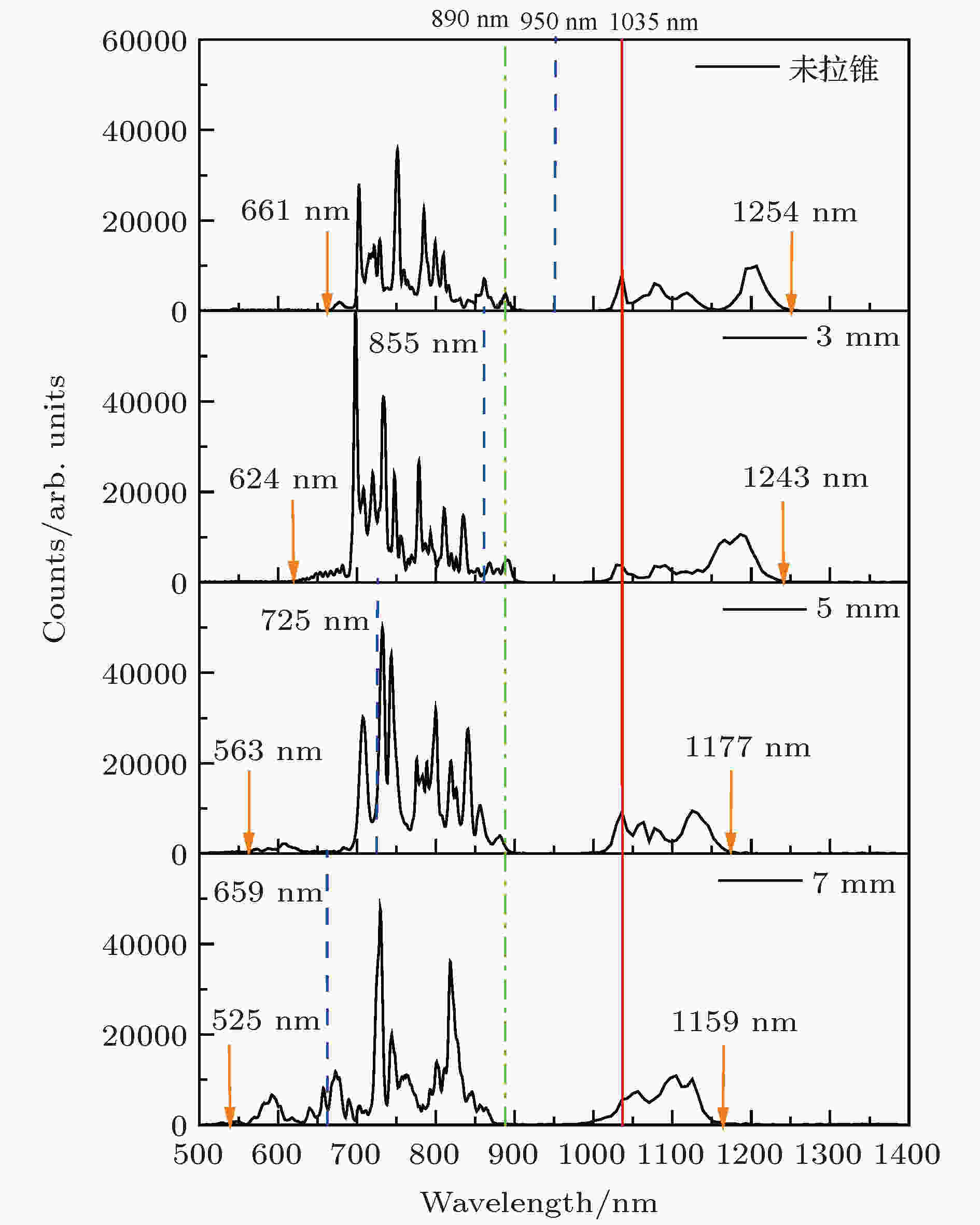 图 11 Yb3+-MSF2拉锥前后光谱图
图 11 Yb3+-MSF2拉锥前后光谱图Figure11. Dispersion curve untapered and tapered Yb3+-MSF2 of the fundamental mode.
